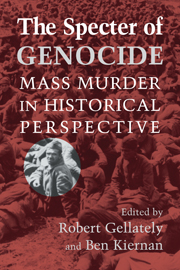Book contents
- Frontmatter
- Contents
- List of Contributors
- Acknowledgments
- INTRODUCTION
- PART I GENOCIDE AND MODERNITY
- PART II INDIGENOUS PEOPLES AND COLONIAL ISSUES
- PART III THE ERA OF THE TWO WORLD WARS
- PART IV GENOCIDE AND MASS MURDER SINCE 1945
- 13 “When the World Turned to Chaos”
- 14 Genocide in Cambodia and Ethiopia
- 15 Modern Genocide in Rwanda
- 16 History, Motive, Law, Intent
- 17 Analysis of a Mass Crime
- CONCLUSIONS
- Appendix: Convention on the Prevention and Punishment of the Crime of Genocide
- Index
16 - History, Motive, Law, Intent
Combining Historical and Legal Methods in Understanding Guatemala's 1981–1983 Genocide
Published online by Cambridge University Press: 05 June 2012
- Frontmatter
- Contents
- List of Contributors
- Acknowledgments
- INTRODUCTION
- PART I GENOCIDE AND MODERNITY
- PART II INDIGENOUS PEOPLES AND COLONIAL ISSUES
- PART III THE ERA OF THE TWO WORLD WARS
- PART IV GENOCIDE AND MASS MURDER SINCE 1945
- 13 “When the World Turned to Chaos”
- 14 Genocide in Cambodia and Ethiopia
- 15 Modern Genocide in Rwanda
- 16 History, Motive, Law, Intent
- 17 Analysis of a Mass Crime
- CONCLUSIONS
- Appendix: Convention on the Prevention and Punishment of the Crime of Genocide
- Index
Summary
For a small country, Guatemala has had an impressive history. Its 1944 October Revolution was one of the first efforts in Latin America to try to make good on the social democratic promise offered by the Allied victory in World War II. In 1954 it had the unfortunate distinction to suffer the first Latin American Cold War coup. That U.S.-sponsored event, in turn, led to two important consequences: throughout the rest of his life, Che Guevara, who was in Guatemala at the time, cited the intervention as a key moment in his political radicalization, and the United States, seven years later, would try to replicate its Guatemalan success in Cuba with the Bay of Pigs intervention. In the 1960s, following the Cuban Revolution, Guatemala was one of the first Latin American countries to develop both a socialist insurgency and an anticommunist counterinsurgency. Practices the United States rehearsed in Guatemala would be applied throughout Latin America in the coming decades. In the 1980s, the final escalation of the superpower conflict turned Guatemala, along with Nicaragua and El Salvador, into one of the Cold War's final battlefields.
In February 1999 the United Nations–administered Historical Clarification Commission (CEH) released the results of its investigation into the political repression that underwrote this history. The commission not only ruled that the state bore overwhelming responsibility for more than 200,000 political murders but that during a particularly brutal period between 1981 and 1983 it had committed acts of genocide against its Mayan population, who makes up 60 percent of a population of 10 million people.
- Type
- Chapter
- Information
- The Specter of GenocideMass Murder in Historical Perspective, pp. 339 - 352Publisher: Cambridge University PressPrint publication year: 2003
- 27
- Cited by



